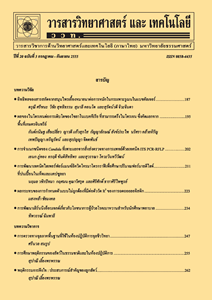ผลของระยะเวลาเพาะเลี้ยงต่อปริมาณสารต้านอนุมูลอิสระของยอดหัวข้าวเย็นเหนือ (Smilax corbularia) ในสภาพปลอดเชื้อ
Main Article Content
Abstract
Abstract
Smilax corbularia Kunth. is a medicinal plant which its rhizomes used to treat cancers and AIDS. Plant tissue culture for propagation of S. corbularia has been studied but there is no report on the effect of in vitro culture periods on its antioxidant contents. Therefore, the objectives of this study was to investigate the effects of culture periods on antioxidant contents of S. corbularia shoots grown under aseptic conditions. Single node segments were cultured on MS (Murashige and Skoog) medium supplemented with 1.0 mg/L BA (benzyladenine), 0.5 mg/L IAA (indole-3-acetic acid) and 15 % (v/v) coconut water for 4, 6, 8, 10 and 12 weeks. The results showed that total phenolic and total flavonoid contents including DPPH radical scavenging activities of S. corbularia regenerated shoots increased along the culture periods. The 12 week-old regenerated shoots exhibited the highest contents of total phenolic (84.92±5.88 mg GAE/g dry extract) and total flavonoid (107.56±7.19 mg CE/g dry extract). The greatest DPPH radical scavenging activity also obtained from the 12 week-old regenerated shoots (EC50 = 15.75±0.88 µg/mL).
Keywords: Smilax corbularia Kunth.; culture period; antioxidant; medicinal plant;
Article Details
References
[2] แก้ว กาญจนา, 2547, ตำราสมุนไพรบำบัดโรคชุดที่ 2 สูตรลับตำรับสมุนไพรรักษาโรคเบาหวาน, สำนักพิมพ์นีออนบุ๊คมีเดีย, นนทบุรี, 100 น.
[3] เพ็ญนภา ทรัพย์เจริญ, 2549, สมุนไพรในอุทยานแห่งชาติภาคกลาง, มูลนิธิการแพทย์แผนไทยพัฒนา, พิมพ์ครั้งที่ 2, บริษัทสามเจริญพาณิชย์, กรุงเทพฯ, 228 น.
[4] Itharat, A., Houghton, P.J., Ammgusye, E.E., Burke, P.J., Sampson, J.H. and Raman, A., 2004, In vitro cytotoxic activity of Thai medicinal plants used traditionally to treat cancer, J. Ethnopharmacol. 90: 33-38.
[5] Li, S.Y., Fuchino, H., Kawahara, N., Sekita, S. and Satake, M., 2002, New phenolic constituents from Smilax bracteata, J. Nat. Prod. 65: 262-266.
[6] Ruangnoo, S., Jaiaree, N., Makchuchit, S., Panthong, S., Thongdeeying, P. and Itharat, A., 2012, An in vitro inhibitory effect on RAW 264.7 cells by antiinflammatory compounds from Smilax corbularia Kunth, Asian Pac. J. Allergy Immunol. 30: 268-74.
[7] Yuan, J.Z., Dou, D.Q., Chen, Y.J., Li, W., Kazuo, K., Tamotsu, N. and Yao, X.S., 2004, Studies on dihydroflavonol glycosides from rhizome of Smilax glabra, China J. Chin. Mate. Med. 29: 867-870.
[8] วราภรณ์ ภูตะลุน, 2551, การเพาะเลี้ยงเนื้อเยื่อพืชสมุนไพร แนวทางการศึกษาเพื่อผลิตสารทุติยภูมิที่มีฤทธิ์ทางเภสัชวิทยา, ขอนแก่นพิมพ์พัฒนา, ขอนแก่น, 120 น.
[9] Jirakiattikul, Y., Rithichai, P. and Itharat, A., 2013, Effects of medium salt strength and plant growth regulators on shoot multiplication and root induction of Smilax corbularia, Pharmacologyonline 3: 1-7.
[10] Wang, J., Qian, J., Yao, L. and Lu, Y., 2015, Enhanced production of flavonoids by methyl jasmonate elicitation in cell suspension culture of Hypericum perforatum, Bioresour. Bioprocess 2: 1-9.
[11] ทิพย์สุคนธ์ บุญยืน, 2557, ผลของ Jasmonic acid และ Salicylic acid ต่อปริมาณ Dioscorealide B ในการเพาะเลี้ยงยอดของข้าวเย็นใต้ (Dioscorea membranacea Pierre ex Prain & Burkill), วิทยานิพนธ์ปริญญาโท, มหาวิทยาลัยธรรมศาสตร์, ปทุมธานี.
[12] Jaiarree, N., 2010, Biological activities of Dioscorea birmanica Prain & Burkill extract and its active ingredients, Ph.D. Thesis, Thammasat University, Pathum Thani.
[13] เจิมอรุณ อุทัยแจ่มศรีผล, เยาวพา จิระเกียรติกุล, ภาณุมาศ ฤทธิไชย และอรุณพร อิฐรัตน์, 2560, ผลของระยะเวลาเพาะเลี้ยงต่อปริมาณสารทุติยภูมิและฤทธิ์ต้านอนุมูลอิสระของยอดพรมมิในสภาพปลอดเชื้อ, ว.วิทยาศาสตร์และเทคโนโลยี 25: 443-452.
[14] Taiz, L. and Zeiger, E., 2006, Plant Physiology, 4th Ed., Sinauer Associates, Inc., Sunderland, 700 p.
[15] ลิลลี่ กาวีต๊ะ, 2546, การเปลี่ยนแปลงสัณฐานและพัฒนาการพืช, โรงพิมพ์มหาวิทยาลัยเกษตร ศาสตร์, กรุงเทพฯ, 319 น.
[16] Rout, G.R., Samantaray, S. and Das, P., 2000, In vitro manipulation and propaga tion of medicinal plants, Biotechnol. Adv. 18: 91-120.
[17] รัชนีวรรณ จิระพงศ์พัฒนา, เยาวพา จิระเกียรติกุล, ภาณุมาศ ฤทธิไชย, ศรีโสภา เรืองหนู และอรุณพร อิฐรัตน์, 2559, ปริมาณสารทุติยภูมิของยอดหัวข้าวเย็น (Dioscorea birmanica Prain & Burkill) ในสภาพปลอดเชื้อที่ระยะเวลาเพาะเลี้ยงต่างกัน, ว.วิทยาศาสตร์และเทคโนโลยี 24: 40-48.
[18] Sabater-Jara, A., Souliman-Youssef, S., Novo-Uzal, E., Almagro, L., Belchi-Navarro, S. and Pedreno, M., 2013, Biotechno logical approaches to enhance the biosynthesis of ginkgolides and bilobalide in Ginkgo biloba, Phytochem. Rev. 12: 191-205.
[19] FigueiróI, A.D.A., CorreaI, C.M., AstaritaI, L.V. and SantarémI, E.R., 2010, Long-term maintenance of in vitro cultures affects growth and secondary metabolism of St. John’s Wort, Cienc. Rural. 40: 2115-2121.
[20] ปพิชญา ขวานทอง, 2559, ผลของ Phenylalanine และ Jasmonic acid ต่อปริมาณสารในกลุ่มฟลาโวนอยด์ของแคลลัสกระเจี๊ยบแดง (Hibiscus sabdariffa Linn.) ในสภาพปลอดเชื้อ, วิทยานิพนธ์ปริญญาโท, มหาวิทยาลัยธรรมศาสตร์, ปทุมธานี.
[21] Cui, X.H., Chakrabarty, D., Lee, E.J. and Paek, K.Y., 2010, Production of adventitious roots and secondary metabolites by Hypericum perforatum L. in a bioreactor, Bioresour. Technol. 101: 4708-4716.
[22] กนกวรรณ ส่งเสริม, 2561, ผลของระยะเวลาเพาะเลี้ยงและ Salicylic Acid ต่อปริมาณสารทุติยภูมิของยอดกล้วยหอมทอง (Musa acuminate AAA group ‘Gros Michel’) ในสภาพปลอดเชื้อ, ปัญหาพิเศษปริญญาโท, มหาวิทยาลัยธรรมศาสตร์, ปทุมธานี.
[23] Szopa, A., Kokotkiewicz, A., Bednarz, M., Luczkiewicz, M. and Ekiert, H., 2017, Studies on the accumulation of phenolic acids and flavonoids in different in vitro culture systems of Schisandra chinensis (Turcz.) Baill. using a DAD-HPLC method, Phytochem. Lett. 20: 462-469.
[24] Anusha, T.S., Joseph, M.V. and Elyas, K.K., 2016, Callus induction and elicitation of total phenolics in callus cell suspension culture of Celastrus paniculatus – willd, an endangered medicinal plant in India, Pharmacogn. J. 8: 471-475.
[25] Makowczynska, J., Grzegorczyk-Karolak, I. and Wysokinska, H., 2015, Antioxidant activity of tissue culture-raised Ballota nigra L. plants grown ex vitro, Acta Pol. Pharm. 72: 769-775.
[26] Ruangnoo, S., 2011, Stabilty and formulation development of Hua-Khao-Yen extracts as anticancer drug, Ph.D. Thesis, Thammasat University, Pathum Thani.
[27] อรอุมา สองศรี, 2556, การเพาะเลี้ยงเนื้อเยื่อหัวข้าวเย็น (Dioscorea birmanica Prain & Burkill) และการสะสมสารทุติยภูมิ, วิทยานิพนธ์ปริญญาโท, มหาวิทยาลัยธรรมศาสตร์, ปทุมธานี.
[28] Mohan, N., Jassal P.S., Kumar, V. and Singh, R.P., 2011, Comparative in vitro and in vivo study of antioxidants and phyto chemical content in Bacopa monnieri, Recent Res. Sci. Technol. 3: 78-83.
[29] Banthorpe, B.V., 1994, Secondary metabolism in plant tissue culture: Scope and limitations, Nat. Prod. Rep. 11: 303-328.
[30] ศุภวรรณ บุญระเทพ, 2549, การผลิตสารทุติยภูมิโดยวิธีการเพาะเลี้ยงเนื้อเยื่อพืชและเทคโนโลยีชีวภาพ, ว.วิจัยวิทยาศาสตร์การแพทย์ 20: 185-196.


